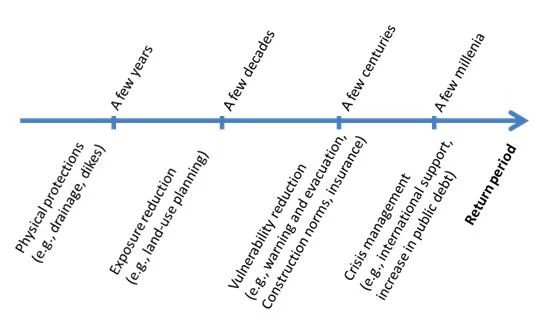For poor countries, building weather and hydrological services to produce reliable forecasts often does not appear as a priority. Such services are seen as a luxury, rather than a necessity, in low income countries. But is it really the case?
In many countries, human and economic losses caused by weather extremes are on the rise, and they sometimes increase more rapidly than wealth. In some regions, natural disasters now represent a significant obstacle to poverty alleviation at the household level (many studies show that disasters can put households in poverty traps) and at the macro level (some regions are affected by regular events and spend a large fraction of their resources for reconstruction instead of development).
Expensive projects are being planned or implemented to mitigate these losses, based for instance on dikes or drainage systems. But under tight financial constraints, expensive risk reduction investments are not keeping pace with increases in population and assets.
And even when physical protections can be built, past experiences show us they can fail, and that protection failures can lead to very heavy human losses. In France in 2010, with the storm Xynthia or in Japan in 2011 with the great tsunami, defense failure or overtopping led to large destruction and many lost lives. These examples demonstrate that structural defenses and “hard” protection cannot be the unique response to disaster risks.
This is why risk management should be done through a policy mix, with different policies targeting different probability of occurrence, as suggested in Figure 1. Some policies will target the events that occur regularly; other policies will target the events that occur exceptionally, for instance once a century. It is impossible for one single policy option to deal with these very different types of extremes.

Figure 1: An example of risk-management policy mix, in which physical protections avoid frequent events; land-use planning limit population and asset exposure if protections are overtopped; weather forecasts, warnings, early warning, evacuation, insurance reduce vulnerability, and help affected regions rebound; and finally crisis management and international solidarity help cope with the largest events.
One particularly interesting policy option in such a policy mix is based on improved early warning capability, which could play a key role in limiting human and economic losses at an affordable cost, and be a useful complement to physical protections and land-use plans. This option is particularly relevant for exceptional events, against which it would be very costly to protect using dikes or land-use plans.
To investigate the potential for this policy option, I propose in a recent World Bank Policy Research working paper a very simple cost-benefit analysis of investing in hydro-meteorological services (i.e. weather and river run-off forecasts) and early warning systems.
The analysis starts by investigating benefits from early warning systems in Europe, in terms of saved lives and reduced disaster asset losses, and for other uses. It estimates that, in Europe, hydro-meteorological information and early warning systems save several hundreds of lives per year, avoid between 460 million and 2.7 billion Euros of disaster asset losses per year, and produce between 3.4 and 34 billion EUR of additional benefits per year through the optimization of economic production in weather-sensitive sectors (agriculture, energy, etc.).
Because of the current situation of hydro-meteorological services – and especially limited funding, lack of qualified workers and poor state of the observation network – such benefits are not realized today in developing countries. The analysis assumes therefore that low-income, lower-middle income, and upper-middle income countries realize respectively 10, 20 and 50% of the gains made in industrialized countries (in relative terms with their own GDP).
The analysis also assumes that the annual probability of death from weather events in developing countries (which is stable in the last decades at approximately 7.5 per million inhabitants and per year) could be reduced to 4 per million thanks to early warning systems (to be compared with 2.2 per million today in rich countries). Such a reduction appears achievable considering past successes in developing countries such as China, Cuba, or Bangladesh.
These simple assumptions lead to potential benefits from upgrading to developed-country standards the hydro-meteorological information production and early warning capacity in all developing countries equal to:
- Between 300 million and 2 billion USD per year of avoided asset losses due to natural disasters, thanks to better preparedness and early protection of goods and equipments;
- An average of 23,000 saved lives per year;
- Between 3 and 30 billion USD per year of additional economic benefits thanks to the optimization of economic activities using weather information (e.g., better agricultural practice, optimized electricity production).
Overall, the total economic benefits would reach up to 32 billion USD per year, and using a willingness to pay to reduce the death probability from weather event could raise this number up to 36 billion USD per year.
Reaping these benefits would not be easy. It requires additional investment in five domains: (1) local observation systems; (2) local forecast capacity; (3) increased capacity to interpret forecasts and translate them into warnings; (4) Communication tools to distribute and disseminate information, data, and warnings; (5) institutional capacity building and increased decision-making capacity by the users of warnings and hydro-meteorological information.
Because some of the most expensive components of early warning systems have already been built (e.g., earth observation satellites, global weather forecasts), the cost of these investments is relatively modest, estimated in the analysis around 1 billion US per year, reaching benefit-cost ratios between 4 and 36.
In spite of the large uncertainty in these estimates, the analysis concludes that far from being a luxury reserved to high income countries, investments in weather forecasts and early warning systems are particularly desirable in low and middle income countries, and that improving them should be part of a development strategy.
View the entire paper, A Cost Effective Solution to Reduce Disaster Losses in Developing Countries: Hydro-Meteorological Services, Early Warning, and Evacuation.


Join the Conversation